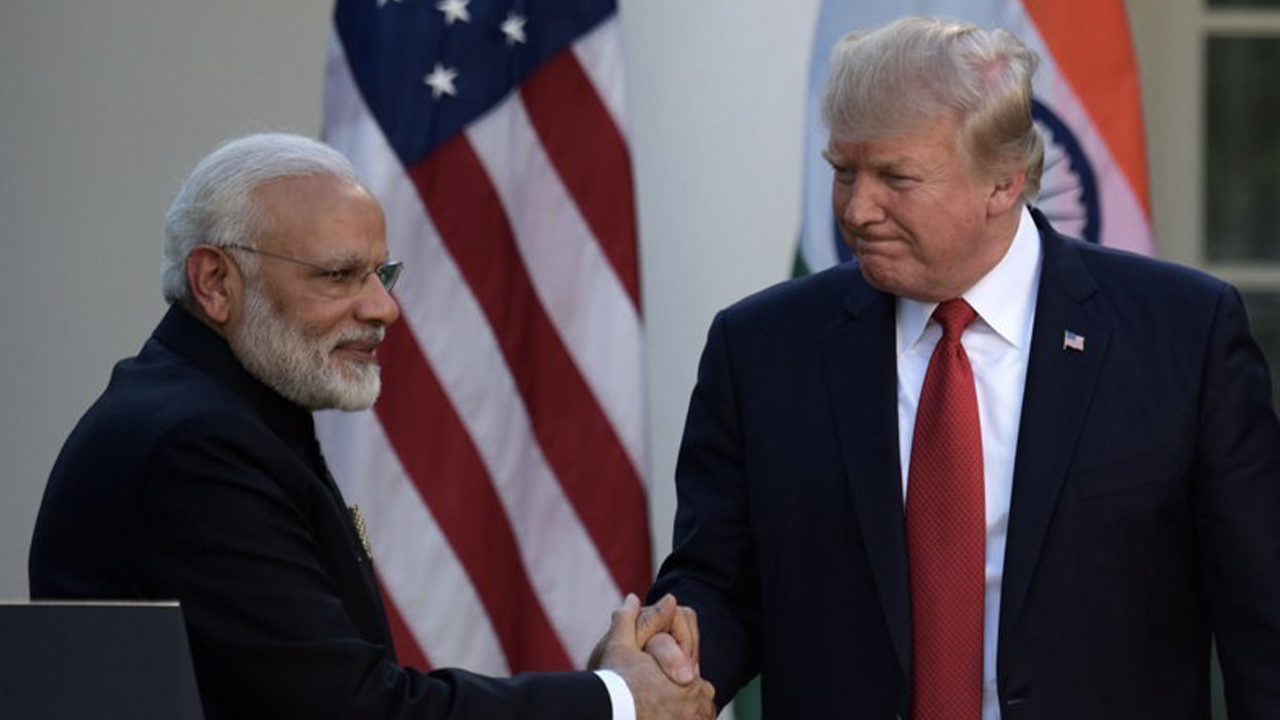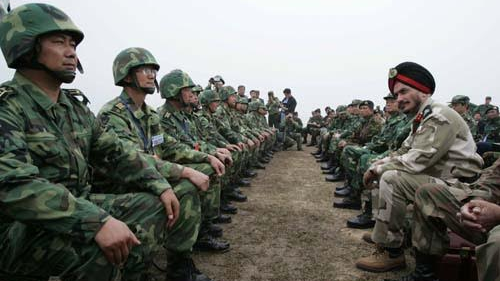
U.S. President Donald Trump (R) and Indian Prime Minister Narendra Modi shake hands after giving joint statements at the White House in Washington, D.C., the United States, June 26, 2017. /Xinhua
U.S. President Donald Trump (R) and Indian Prime Minister Narendra Modi shake hands after giving joint statements at the White House in Washington, D.C., the United States, June 26, 2017. /Xinhua
Editor's note: Iram Khan is a Pakistan-based commentator on international affairs. The article reflects the author's opinions, and not necessarily the views of CGTN.
To be perceived as America's rival is one thing, to be its partner is another. U.S. President Donald Trump launched a tariff war against China because he felt threatened – justly or otherwise – from its rise as the next economic power. In the case of India, American policymakers are treading a fine line in supporting its regional aims, while keeping a check on a possible overshadow of their interests.
India is not the first country to feel the heat from this U.S. approach. Japan in the 1980s and the EU in the past three years have gained ample experience of what it takes to be America's trade partner. The carrot and stick policy of the Office of the U.S. Trade Representative (USTR), unfortunately, does not differentiate much between friends and foes.
In June, 2019, when the U.S.-India bonhomie was still growing, the U.S. abruptly suspended the Generalized System of Preferences (GSP) for India that allowed exemptions from tariffs. Losses were in the millions. Now that Trump is toying with the idea of pushing American manufacturers out of China, his administration is still reluctant to restore the GSP.
In an online session last week, Kenneth Juster, U.S. ambassador to India linked the restoration to India's willingness to open up for free trade. But allowing free trade puts the Indian government in an insecure position. Although it portrays itself on par with China's manufacturing prowess, multinational entities very well know the situation on the ground.
The U.S. ambassador went a step ahead and pointed at the need for reciprocity in bilateral trade with India. He even lamented the fact that the two countries do not have big enough vision for a trade relationship. No wonder Trump came down hard on India in 2018, accusing it of being "the tariff king."
The U.S. is also uneasy with overly protectionist Indian regulations. Just last month, USTR launched an investigation against India for discriminatorily levying digital services tax on American companies. On conclusion, the investigation can lead to punitive tariffs and a further deterioration of relations.
In the wake of a border clash with China on June 15, India weaponized its trade by introducing extra scrutiny for Chinese shipments. Backfiring immediately, the move caused heavy losses for local industries dependent upon these imports and ended up disrupting operations of American companies in India. The representative group of American companies voiced reservations on the unpredictability of Indian policies.

The talks led by China's Southern Xinjiang Military District chief and India's 14 Army Corps commander are held on the Chinese side of the Line of Actual Control at the China-India border area, June 6, 2020. /Xinhua
The talks led by China's Southern Xinjiang Military District chief and India's 14 Army Corps commander are held on the Chinese side of the Line of Actual Control at the China-India border area, June 6, 2020. /Xinhua
The U.S., on the other hand, frequently engages in practices that ensure it remains the dominant partner in this precarious courtship. In April, when India placed a ban on the export of hydroxychloroquine, Trump publicly threatened with retaliation since he had been touting it as a cure for COVID-19. Days later, India rendered its compliance, proving the lopsidedness of the relationship.
Law enforcement regimes of India and the U.S. are entirely different: one being lenient while the other generously strict. Yet, each is prone to politicization. As Trump is aggressively using government machinery in his re-election bid, Indian Prime Minister Narendra Modi is using it to assuage public opinion in the fallout of the border incident with China.
Both systems are also incompatible to an extent. The leniency of India's enforcement mechanism lets many dubious businesses operate with impunity. When interacting with the American legal system, they can find themselves in hot water. This is a major concern for foreign investors who collaborate with companies in India.
In the hopes of securing auspices from the west, India has made a grave mistake of ignoring the east – especially its immediate neighborhood. Regional Comprehensive Economic Partnership (RCEP) is an agreement between the Association of Southeast Asian Nations (ASEAN) and its Free Trade Agreement (FTA) partners aimed at liberalizing economies of participating members. India has withdrawn from this ambitious initiative and separated itself from the Asian markets.
The twenty-first century belongs to Asia. But with departure from treaties like the RCEP, India's "look east" policy is in tatters. At the same time, by not receiving any substantial concessions from the west, it is missing out on the benefits from both.
While India tried to capitalize on the Trump administration's attempt at wooing American companies away from China, there is little chance that it will stand to gain anything. A survey carried out by the American chambers of commerce in Beijing and Shanghai revealed in April that these companies were neither considering relocation nor were changing their supply chain strategies.
That's because moving back to the U.S. does not make manufacturing economically feasible, and moving to India comes with its own problems. India may be good at churning out tennis shoes or T-shirts but there is a long way until it catches up with China's industrial capabilities.
India and the U.S. are in ways directly competing against each other. Modi has rebranded his "Make in India" campaign to "Atma Nirbhar Bharat", whereas Trump is peddling his "Made in America" mantra with the promise of creating more jobs.
When the question of their mutual trade arises, they are far from being compatible allies. Wary of disparate priorities, they seldom find common ground to expand the value of commerce between them. Both are looking inward by trying to offer investors something that China can't. But, put simply, there is nothing as such.
(If you want to contribute and have specific expertise, please contact us at opinions@cgtn.com.)